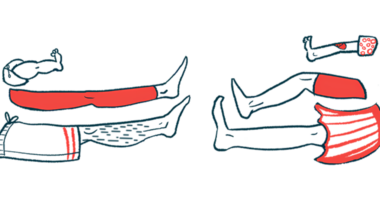Parkinson’s subtypes may be ID’d by analyzing nerves in the eyeball
Average length, density of corneal nerves were larger with TD than PIGD subtype

Measuring the length and density of nerves in the cornea — the clear outer layer of the eyeball — can help distinguish between motor subtypes of Parkinson’s disease, a new study suggests.
The study, “The severity of corneal nerve loss differentiates motor subtypes in patients with Parkinson’s disease was published in Therapeutic Advances in Neurological Disorders.
Parkinson’s can cause a range of motor symptoms. Depending on which symptoms are most apparent, the disease may be divided into tremor-dominant (TD) or postural instability and gait disturbance (PIGD) subtypes. The former is marked by more tremors, the latter by greater problems with walking and balance. Generally, patients with the TD subtype have a better response to treatment and fewer cognitive issues.
The cornea, the outermost layer of the eye, contains a number of small nerve fibers, including nerves that help trigger a blink reflex when something touches the eyes. Prior research has suggested these nerves tend to degrade in people with Parkinson’s, particularly those with cognitive problems, but how these nerves are affected in TD or PIGD subtypes hasn’t been studied.
A team led by scientists in China used a technique called corneal confocal microscopy to assess the health of nerves in the corneas of 73 Parkinson’s patients — 29 with TD, 34 with PIGD, and 10 with a mixed subtype. Patients with PIGD tended to report more severe disease and worse quality of life, which the researchers said is consistent with other studies on differences among subtypes.
Results showed the average length and density of corneal nerves were significantly larger among patients with the TD type than the PIGD form. TD patients also tended to have more densely branched and interconnected corneal nerves (suggesting more healthy connections among the nerves). Patients with the mixed subtype tended to fall between the two other types in corneal nerve health measures.
“In this study, we show that patients with the PIGD subtype have greater corneal nerve loss” than those with the TD subtype, the researchers said.
The scientists then tested whether the combination of three corneal nerve parameters (length, density, and branch density) could help distinguish between PIGD and TD subtypes.
The researchers calculated the area under the receiver operating characteristic curve, or AUC, a statistical measure of how well a given test can distinguish between two groups. AUC values can range from 0.5 to 1, with higher numbers reflecting a better ability to distinguish the groups.
The AUC of the three corneal nerve parameters for distinguishing between PIGD and TD Parkinson’s patients was 0.83.
“Combined corneal nerve parameters have an excellent diagnostic utility for differentiating the TD from the PIGD subtypes, with an AUC of 0.832,” said the researchers, who called for further research to test whether evaluating corneal nerves might help distinguish between Parkinson’s subtypes and predicting patients’ prognosis.







